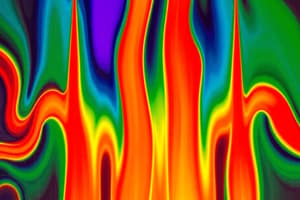Podcast
Questions and Answers
What is the primary driving force behind heat transfer from one substance to another?
What is the primary driving force behind heat transfer from one substance to another?
- Phase change
- Molecular organization
- Temperature difference (correct)
- Energy gain or loss
What happens when liquid water is put into a freezer?
What happens when liquid water is put into a freezer?
- The water molecules remain unchanged
- The water molecules lose energy and turn into solid (correct)
- The water molecules change into a different type of matter
- The water molecules gain energy and turn into gas
What is the result of heat being transferred from a stove to a pot of water?
What is the result of heat being transferred from a stove to a pot of water?
- The water molecules remain unchanged
- The water molecules slow down
- The water molecules gain energy and heat up (correct)
- The water molecules change into a different type of matter
What is the definition of energy?
What is the definition of energy?
Why does a pot of water boil when heated on a stove?
Why does a pot of water boil when heated on a stove?
What is the term for the process by which a substance changes from one phase to another?
What is the term for the process by which a substance changes from one phase to another?
What is the purpose of heat in many scientific pursuits?
What is the purpose of heat in many scientific pursuits?
What is the primary method of heat transfer through which the sun warms the ground?
What is the primary method of heat transfer through which the sun warms the ground?
What is the unit of temperature used by scientists?
What is the unit of temperature used by scientists?
What happens to the temperature of water when it reaches its boiling point?
What happens to the temperature of water when it reaches its boiling point?
What is the effect of adding salt to water on its boiling point?
What is the effect of adding salt to water on its boiling point?
What is the relationship between pressure and temperature according to Boyle's Law?
What is the relationship between pressure and temperature according to Boyle's Law?
What is the temperature at which all kinetic energy within molecules ceases?
What is the temperature at which all kinetic energy within molecules ceases?
What is the result of heat transfer on the molecules of a substance?
What is the result of heat transfer on the molecules of a substance?
What is the primary reason why heat transfer occurs?
What is the primary reason why heat transfer occurs?
Flashcards are hidden until you start studying
Study Notes
What is Heat?
- Heat is energy transferred from one substance to another due to temperature differences
- Heat is generated by a source (e.g., stove) and transferred to another substance (e.g., pot and water)
- Heat is transferred through three main methods: radiation, conduction, and convection
Phases of Matter
- Water has three phases: solid (ice or snow), liquid (water), and gas (water vapor, steam, or clouds)
- A phase change occurs when energy is added or lost, altering the phase of a substance
- Energy is required for a substance to change from one phase to another
Heat Transfer
- Heat transfer occurs due to temperature differences, with molecules trying to establish temperature equilibrium
- Radiation: heat energy is transferred through electromagnetic radiation (e.g., sun warming the ground)
- Conduction: heat is transferred directly from one substance to another (e.g., stove heating a pot)
- Convection: heat is transferred through liquids (e.g., heating hot soup on a stove)
Temperature
- Temperature is the average kinetic energy of a substance, reflecting the energy put into it
- Temperature is measured in three scales: Kelvin, Celsius, and Fahrenheit
- Water boils at 373.15 K, 100°C, and 212°F, and freezes at 273.15 K, 0°C, and 32°F
The Relationship of Temperature and Heat
- Temperature, heat, and heat transfer are deeply related
- Temperature is dictated by the heat energy transferred to or lost by a substance
- Molecules tend to get closer together as temperature (kinetic energy) decreases
Studying That Suits You
Use AI to generate personalized quizzes and flashcards to suit your learning preferences.




